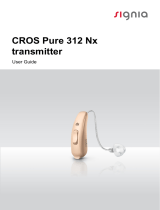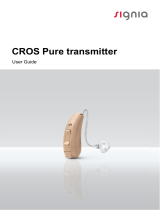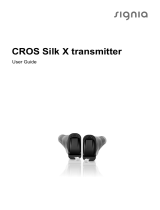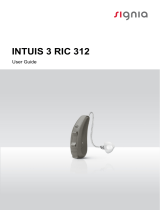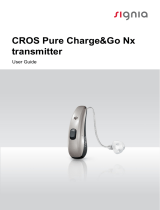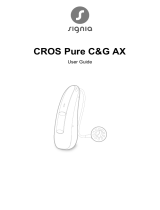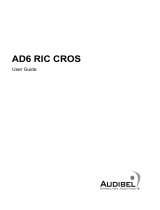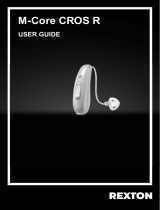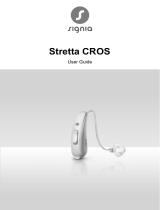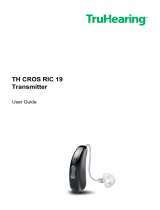Page is loading ...

CROS Pure Charge&Go X
transmitter
User Guide

2
Content
Welcome 4
Your CROS transmitter 5
Components and names 7
Controls 9
Hearing programs 10
Signal tones 10
Daily use 11
Charging 11
Turning on and o 12
Switching to andby mode 13
Inserting and removing the transmitter 14
Changing the hearing program 18
Bluetooth 18
Maintenance and care 19
Transmitter 19
Ear pieces 21
Professional maintenance 23
Important safety information 24

3
Further information 26
Safety information 26
Accessories 26
Explanation of symbols 26
Operating, transport, and orage conditions 28
Disposal information 29
Troubleshooting 30
Conformance information 31
Country-specic information 33
Important safety information 34
Personal safety 34
Product safety 37
Service and warranty 39

4
Welcome
Thank you for choosing one of our hearing inrument
accessories.
This guide, along with support from your Hearing Care
Professional, will help you underand the advantages
and greater quality of life this accessory oers.
CAUTION
It is important to read this user guide thoroughly
and completely. Follow the safety information to
avoid damage or injury.

5
Your CROS transmitter
CROS solutions are designed for people with profound
hearing loss in one ear which can not be aided with a
hearing inrument. A CROS transmitter worn on this
ear captures sound from this side and transmits it to
the hearing inrument on the other ear. This allows the
wearer of the hearing inrument to hear sounds from
both sides.
CROS transmitter hearing inrument

6
Two solutions are available:
● CROS solution:
For people with normal hearing in one ear and
profound hearing loss in the other. Sounds from the
side with hearing loss are captured and transmitted
wirelessly to the good-hearing side.
● BiCROS solution:
For people with profound hearing loss in one ear
and less severe hearing loss in the other. Sounds
from the more severe hearing loss side are captured
and transmitted wirelessly to the better-hearing side.
The hearing inrument processes and amplies the
sounds from both sides.
The CROS transmitter works with our specic wireless
hearing inruments. Your Hearing Care Professional will
advise you on the compatible models.
NOTICE
This user guide only applies to the CROS
transmitter. Your hearing inrument has a separate
user guide.

7
Components and names
➎
➎
➌
➊Ear piece
➋Receiver
➌Receiver cable
➍Microphone openings
➎Rocker switch
(control, on/o switch)
➏Side indicator
(red = right ear,
blue = left ear) and
receiver connection

8
You can use the following andard ear pieces:
Standard ear pieces Size
Click Sleeve
(vented or closed)
Click Dome™ single
(open or closed)
Click Dome semi-open
Click Dome double
You can easily exchange the andard ear pieces. Read
more in section "Maintenance and care".
Cuom-made ear pieces
Cuom shell
Click Mold™

9
Controls
With the rocker switch you can, for example, switch
hearing programs. The Hearing Care Professional has
programmed your desired functions to the rocker switch.
Rocker switch function L R
Press briey:
Program up/down
Press for about 2 seconds:
Program up/down
Press for more than 3 seconds:
Turn on/o
L = Left, R = Right
You can also use a remote control to change
hearing programs and adju the volume of your
hearing inrument. With our smartphone app you
have even more control options.

10
Hearing programs
1
2
3
4
5
6
Read more in section "Changing the hearing program".
Signal tones
Signal tones of the CROS transmitter - like a low battery
beep - are sent to the hearing inrument.
Ask your Hearing Care Professional to congure the
signal tones.

11
Daily use
Charging
Place your device in the charger.
XFollow the inructions in the
charger's user guide. You
can also nd useful tips for
charging in the charger's
user guide.
Low power indication
You will hear an alert signal
to indicate the power cell is
running low. The signal will be
repeated every 20 minutes. Depending on the usage of
your device, you have approximately 1.5 hours to charge
your device before it ops working.

12
Turning on and off
You have the following options to turn your device
on or o.
Via charger:
XTurning on: Take the device out of the charger.
The artup melody is played in your device. The
default volume and hearing program are set.
XTurning o: Place the device in the charger.
Note that the charger mu be connected to the power
supply. For details refer to the charger's user guide.
Via rocker switch:
XTurning on: Press and hold the lower
part of the rocker switch until the
artup melody arts to play. Release
the rocker switch while the melody is
playing.
The default volume and hearing
program are set.
XTurning o: Press and hold upper
or lower part of the rocker switch
for several seconds. A power down
melody is played.
See also the tips for charging in the charger's user guide.

13
Switching to andby mode
Via remote control or smartphone app, you can switch
your device to andby mode. This mutes the device.
When you leave andby mode, the previously used
volume and hearing program are set.
Note:
● In andby mode, the device is not turned o
completely. It draws some power.
Therefore we recommend to use andby mode only
for a short period of time.
● If you want to leave andby mode, but the remote
control or app is not at hand: Turn your device o and
on again (via rocker switch or by shortly placing it in
the charger until one or more orange LEDs light up).
In this case, the default volume and hearing program
are set.

14
Inserting and removing the transmitter
Colored markers indicate the side:
● red marker = right ear
● blue marker = left ear
Inserting:
XFor Click Sleeves, take care that the
bend of the Click Sleeve is in line with
the bend of the receiver cable.
Correct:
Incorrect:

15
XHold the receiver cable at the bend closer to the
ear piece.
XCarefully push the ear piece in
the ear canal ➊.
XTwi it slightly until it sits well.
Open and close your mouth to
avoid accumulation of air in the
ear canal.
XLift the device and slide it over
the top of your ear ➋.
CAUTION
Risk of injury!
XInsert the ear piece carefully and not too deeply
into the ear.
● It may be helpful to insert the right device with
the right hand and the left device with the left
hand.
● If you have problems inserting the ear piece,
use the other hand to gently pull your earlobe
downwards. This opens the ear canal and eases
insertion of the ear piece.

16
The optional retention rand helps to securely retain the
ear piece in your ear. To position the retention rand:
XBend the retention rand and
position it carefully into the
bottom of the bowl of your ear
(refer to the picture).

17
Removing:
XLift the device and slide it over
the top of your ear ➊.
XIf your device is equipped
with a cuom shell or a
Click Mold, remove it by
pulling the small removal cord
toward the back of your head.
XFor all other ear pieces: Grip the receiver in the
ear canal with two ngers and pull it carefully out ➋.
Do not pull the receiver cable.
CAUTION
Risk of injury!
XIn very rare cases the ear piece could remain
in your ear when removing the device. If this
happens, have the ear piece removed by a
medical professional.
Clean and dry your device after usage. Read more in
section "Maintenance and care".

18
Changing the hearing program
Depending on the liening situation, your device
automatically adju their sound.
Your device may also has several hearing programs
which allow you to change the sound, if needed. An
optional signal tone can indicate the program change.
XTo change the hearing program, press the rocker
switch briey.
Refer to section "Controls" for the setting of the rocker
switch. Refer to section "Hearing programs" for a li of
your hearing programs.
The default volume is applied.
Bluetooth
Your device is equipped with Bluetooth wireless
technology to enable audio reaming from mobile
phones or other compatible devices.
In an airplane, the use of Bluetooth functionality may
be rericted, especially during take-o and landing. If
this is the case, you can switch o Bluetooth wireless
technology in your device via the smartphone app.

19
Maintenance and care
To prevent damage it is important that you take care of
your device and follow a few basic rules, which will soon
become a part of your daily routine.
Transmitter
Cleaning
Your device has a protective coating. However, if not
cleaned regularly you may damage the device or cause
personal injury.
XClean your device daily with a soft, dry tissue.
XNever use running water or immerse the
devices in water.
XNever apply pressure while cleaning.
XAsk your Hearing Care Professional for recommended
cleaning products, special care sets, or more
information on how to keep your device in good
condition.
Drying
Your charger dries the device while charging. You can
also use conventional products to dry your device. Ask
your Hearing Care Professional for recommended drying
products and for individual inructions on when to dry
your device.

20
Storage
● Short-term orage (up to several days): Turn o your
device via the rocker switch or place it in the powered
charger.
The charger mu be connected to the power supply.
If the charger is not connected to power supply and
you place your device in the charger, the device is not
turned o.
Note that when you turn o the device via a remote
control or smartphone app, the device is not turned o
completely. It is in andby-mode and ill draw some
power.
● Long-term orage (weeks, months, ...): Fir, fully
charge your device. Turn it o via the rocker switch
before oring it. We recommend using drying products
while oring the device.
At 6 month intervals you will have to charge the device
to avoid an unrecoverable deep-discharge of the
power cell. Deep-discharged power cells cannot be
charged anymore and they have to be replaced. We
recommend recharging more frequently than 6 month
intervals.
Observe the orage conditions in section
"Operating, transport and orage conditions".
/

